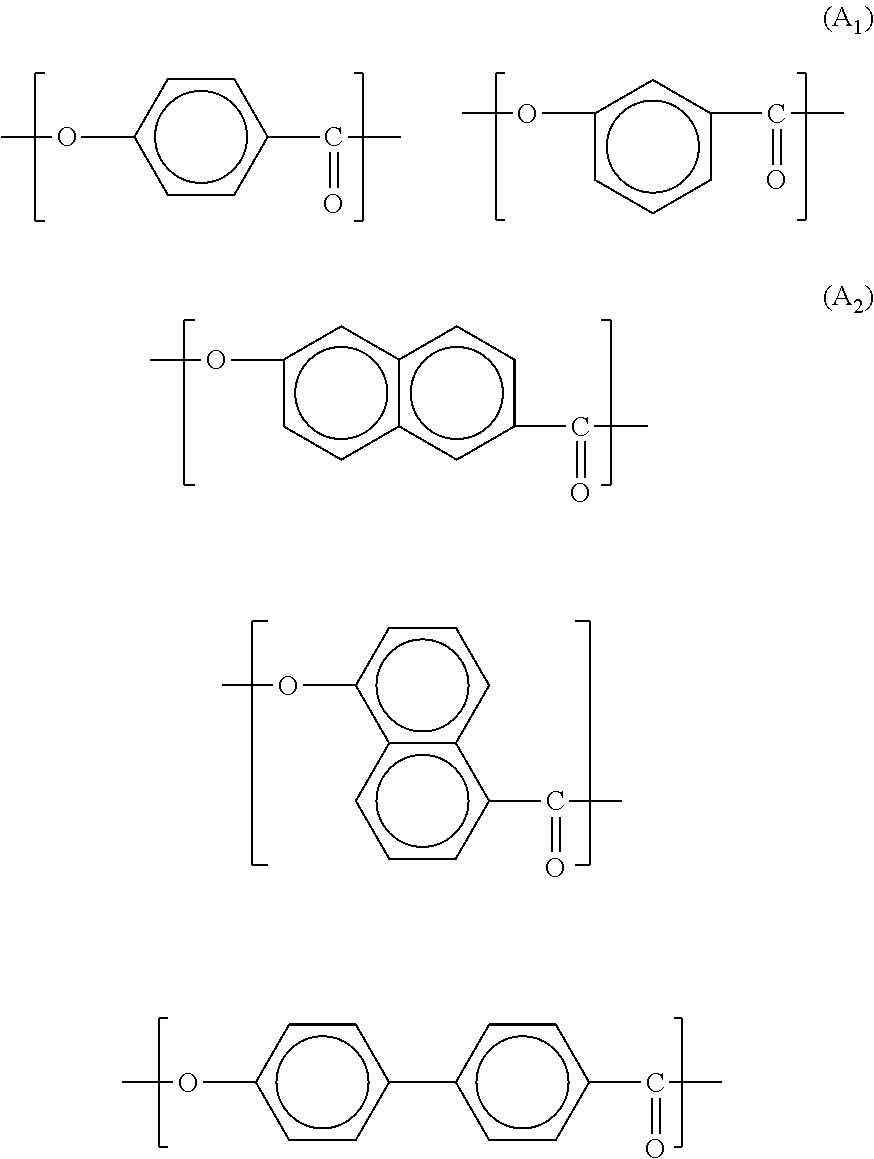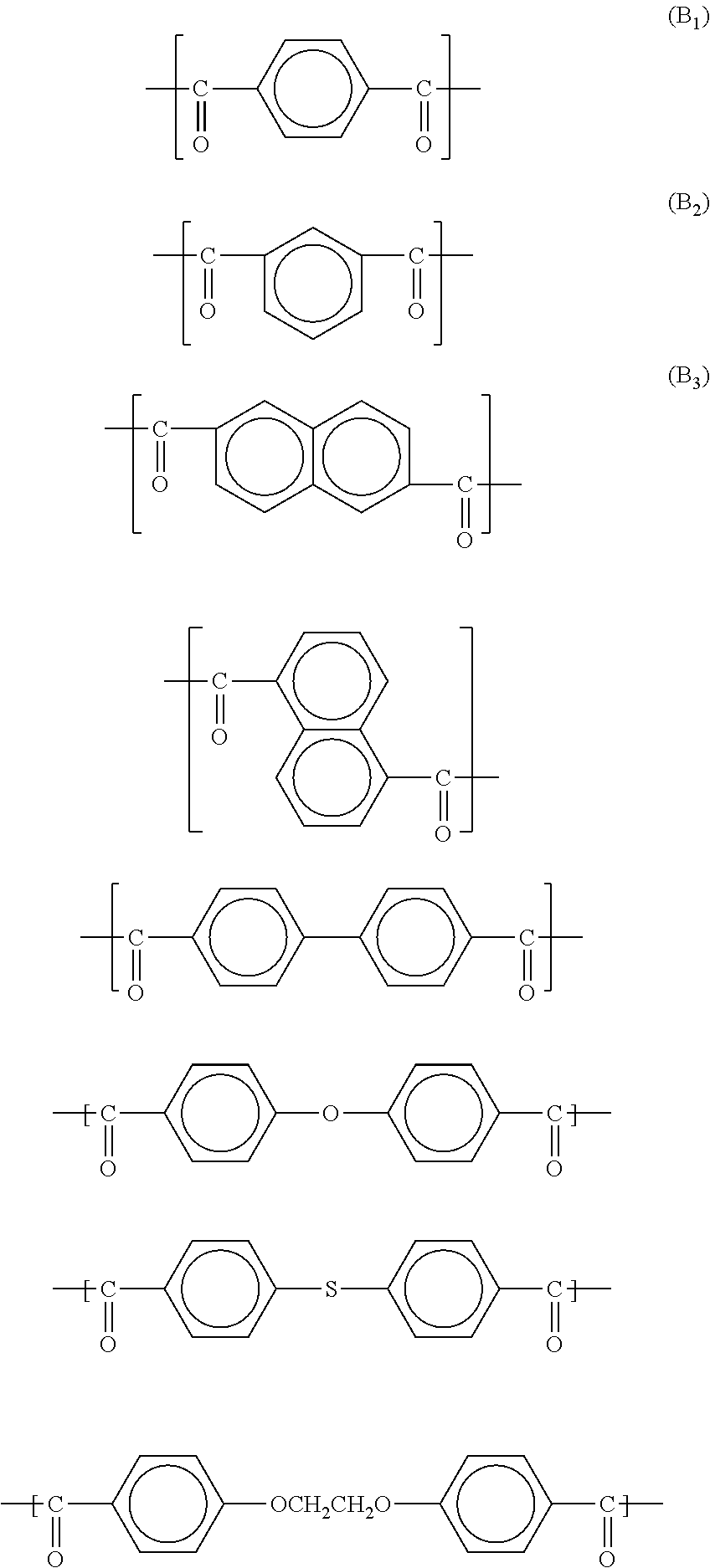Liquid-crystal polyester resin composition
a polyester resin and liquid crystal technology, applied in the direction of non-metal conductors, conductors, transportation and packaging, etc., can solve the problems of low mechanical properties of adverse influences on electronic precision circuits using such liquid crystal polyester resin compositions, and inability to use in applications in which electric conductivity is undesirable such as parts of electronic precision circuits except circuits, etc., to achieve good mechanical properties
- Summary
- Abstract
- Description
- Claims
- Application Information
AI Technical Summary
Benefits of technology
Problems solved by technology
Method used
Image
Examples
reference example 1
[0065]Into a reactor equipped with a stirrer, a torque meter, a nitrogen gas inlet tube, a thermometer and a reflux condenser, p-hydroxybenzoic acid (994.5 g, 7.2 moles), 4,4′-dihydroxybiphenyl (446.9 g, 2.4 moles), terephthalic acid (299.0 g, 1.8 moles), isophthalic acid (99.7 g, 0.6 mole) and acetic anhydride (1347.6 g, 13.2 moles) were charged. After purging the interior of the reactor with nitrogen gas, the reaction mixture in the reactor was heated up to 150° C. over 30 minutes under the nitrogen gas stream, and then refluxed for 3 hours while maintaining the temperature at 150° C. Thereafter, the reaction mixture was heated up to 320° C. over 2 hours and 50 minutes while evaporating off by-produced acetic acid and unreacted acetic anhydride. When the increase of a torque was recorded, the reaction was regarded as being completed, and the content was removed from the reactor. The solid obtained was cooled to room temperature and coarsely milled, and the milled solid was heated ...
reference example 2
[0066]Into a reactor equipped with a stirrer, a torque meter, a nitrogen gas inlet tube, a thermometer and a reflux condenser, p-hydroxybenzoic acid (994.5 g, 7.2 moles), 4,4′-dihydroxybiphenyl (446.9 g, 2.4 moles), terephthalic acid (299.0 g, 1.8 moles), isophthalic acid (99.7 g, 0.6 mole) and acetic anhydride (1347.6 g, 13.2 moles) were charged. After purging the interior of the reactor with nitrogen gas, the reaction mixture in the reactor was heated up to 150° C. over 30 minutes under the nitrogen gas stream, and then refluxed for 3 hours while maintaining the temperature at 150° C. After that, 1-methylimidazole (2.4 g) was added and then the reaction mixture was heated up to 320° C. over 2 hours and 50 minutes while evaporating off by-produced acetic acid and unreacted acetic anhydride. When the increase of a torque was recorded, the reaction was regarded as being completed, and the content was removed from the reactor. The solid obtained was cooled to room temperature and coar...
PUM
| Property | Measurement | Unit |
|---|---|---|
| specific surface area | aaaaa | aaaaa |
| volume resistivity | aaaaa | aaaaa |
| diameter | aaaaa | aaaaa |
Abstract
Description
Claims
Application Information
 Login to View More
Login to View More - R&D
- Intellectual Property
- Life Sciences
- Materials
- Tech Scout
- Unparalleled Data Quality
- Higher Quality Content
- 60% Fewer Hallucinations
Browse by: Latest US Patents, China's latest patents, Technical Efficacy Thesaurus, Application Domain, Technology Topic, Popular Technical Reports.
© 2025 PatSnap. All rights reserved.Legal|Privacy policy|Modern Slavery Act Transparency Statement|Sitemap|About US| Contact US: help@patsnap.com



